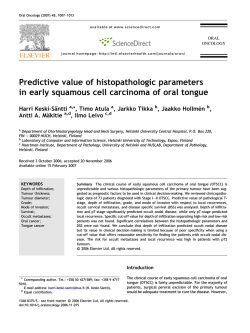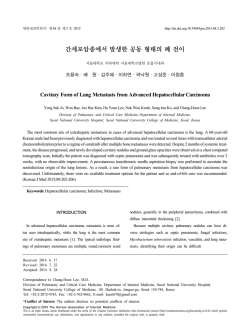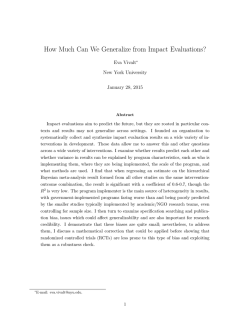
A meta-analysis of the randomized controlled trials
Oral Oncology 47 (2011) 320–324 Contents lists available at ScienceDirect Oral Oncology journal homepage: www.elsevier.com/locate/oraloncology Review A meta-analysis of the randomized controlled trials on elective neck dissection versus therapeutic neck dissection in oral cavity cancers with clinically node-negative neck Ayotunde J. Fasunla a,c, Brandon H. Greene b, Nina Timmesfeld b, Susanne Wiegand a, Jochen A. Werner a, Andreas M. Sesterhenn a,⇑ a Department of Otolaryngology, Head and Neck Surgery, Philipps-University of Marburg, Germany Institute for Medical Biometry and Epidemiology, Philipps-University of Marburg, Germany c Department of Otorhinolaryngology, College of Medicine, University of Ibadan and University College Hospital, Ibadan, Nigeria b a r t i c l e i n f o Article history: Received 28 January 2011 Received in revised form 7 March 2011 Accepted 8 March 2011 Available online 2 April 2011 Keywords: Elective neck dissection N0 neck Observation Oral cancer Therapeutic neck dissection s u m m a r y There is still no consensus on the optimal treatment of the neck in oral cavity cancer patients with clinical N0 neck. The aim of this study was to assess a possible benefit of elective neck dissection in oral cancers with clinical N0 neck. A comprehensive search and systematic review of electronic databases was carried out for randomized trials comparing elective neck dissection to therapeutic neck dissection (observation) in oral cancer patients with clinical N0 neck. A meta-analysis of the studies which met our defined selection criteria was performed using disease-specific death as the primary outcome, and the relative risk (RR) of disease-specific death was calculated for each of the identified studies. Both fixed-effects (Mantel–Haenszel method) and random-effects models were applied to obtain a combined RR estimate, although between-study heterogeneity was not found to be significant as indicated by an I2 of 8.5% (p = 0.350). Four studies with a total of 283 patients met our inclusion criteria. The results of the meta-analysis showed that elective neck dissection reduced the risk of disease-specific death (fixedeffects model RR = 0.57, 95% CI 0.36–0.89, p = 0.014; random-effects model RR = 0.59, 95% CI 0.37–0.96, p = 0.034) compared to observation. This reduction in disease-specific death rate supports the need to perform elective neck dissection in oral cancers with clinical N0 neck. Ó 2011 Elsevier Ltd. All rights reserved. Introduction There is no greater controversy on the management of oral cancers than the optimal treatment for clinically node-negative neck (N0 neck).1–9 Researchers have reported that P30% of oral cancer patients with clinical N0 neck harbor occult metastases, depending on the size and site of the primary tumor and the histological diagnostic methods.10,11 However, the greatest challenge faced by head and neck oncologists and surgeons is the correct identification of the subset of these patients without cervical nodal micro metastases who do not require elective neck treatment. Clinical palpation of the neck is grossly inadequate.12–14 Available radiological investigative tools have shown some improvements in the detection of neck metastasis but sensitivity ranged between 70% and 80%.15–19 Although oral carcinoma is a locally aggressive disease with a great tendency for loco-regional and distant metastasis, the reality ⇑ Corresponding author. Address: Department of Otolaryngology, Head and Neck Surgery, University Hospital Giessen and Marburg GmbH, Standort Marburg, Deutschhausstrasse 3, D-35037 Marburg, Germany. Tel.: +49 06421 58 66811; fax: +49 06421 58 66367. E-mail address: [email protected] (A.M. Sesterhenn). 1368-8375/$ - see front matter Ó 2011 Elsevier Ltd. All rights reserved. doi:10.1016/j.oraloncology.2011.03.009 is that some patients with a clinical N0 neck do not actually have cancer cells in the cervical lymphatics. Treating these necks may mean incurring unnecessary costs, prolongation of hospital stay and causation of avoidable morbidity. However, when a clinical N0 neck with actual micro metastases is not included in the management plan for these patients, the implications are poor treatment outcome with increased morbidity and mortality rates. Unfortunately, there is still no consensus on the elective treatment of the neck in oral cavity cancers with clinical N0 neck. Many available retrospective studies on oral cancer patients with clinical N0 necks have not been helpful in resolving this problem.3,5,20 A few prospective studies are available, but there is still inconclusive evidence on whether elective neck dissection is of any benefit over therapeutic neck dissection.2,6,8,9 Most of these studies have small sample sizes. A meta-analysis of randomized controlled trials could help to answer questions regarding the possible benefit of elective neck treatment in these patients. This study is therefore aimed at systematically reviewing the available literature and carry out a meta-analysis on the existing randomized controlled trials which compared elective neck dissection with therapeutic neck dissection in oral carcinoma patients with clinical N0 neck. A.J. Fasunla et al. / Oral Oncology 47 (2011) 320–324 Materials and methods Search strategy and eligibility criteria We carried out a comprehensive search (Fig. 1) for articles published in the electronic databases MEDLINE (1966–2010), EMBASE (1988–2010), Cochrane Central Register of Controlled Trials, Scopus and Google scholar using the key terms ‘‘randomized controlled trial’’, ‘‘oral cavity cancers’’, ‘‘elective neck dissection’’, ‘‘therapeutic neck dissection’’, ‘‘observation’’ and ‘‘N0 neck’’. All, and then some of these terms were used in combination for the search. The reference list of each article obtained was checked for further potential studies. Only randomized controlled trials which compared elective neck dissection (END) with observation/therapeutic neck dissection (OBS) in patients with squamous cell carcinoma of the oral cavity, which had no clinical or radiological evidence of neck node metastasis (clinical N0 neck), were eligible for inclusion in the meta-analysis. In all studies, the END groups had primary neck dissection at the time of the treatment of the primary tumor and the OBS groups had treatment of the primary tumor only, while the neck was put under close observation during follow-up, and neck dissection was performed only when neck node metastasis was detected (therapeutic neck dissection). Data extraction Data from the studies were first extracted and assessed by the principal investigator (AF) and thereafter, independently by two co-authors (BG, NT) using standardized data forms. In addition to information about study design, patient characteristics (Table 1) and sample size, numbers of disease-specific deaths in each group 613 records identified through database searching 321 and corresponding follow-up times were extracted. The overall number of deaths and the number of neck recurrences and metastases (Table 2) were also extracted. Disease-specific death as the primary endpoint for meta-analysis was chosen. The authors of one study9 were contacted to obtain information regarding group-specific overall death rates. Statistical analysis The analysis was performed using the R program for statistical computing (R 2.10.1; ‘‘meta’’ package). The relative risk (RR) of disease-specific death and 95% confidence interval (CI) were calculated for each individual study. However, due to the small number of studies included, both fixed-effects (Mantel–Haenszel method) and random-effects models (DerSimonian and Laird21 method) were applied to obtain a combined RR estimate, 95% CI and p-value. The inverse variance method of weighting studies (results not shown) was also used, but the results of the meta-analysis did not differ between these methods with regard to combined RR estimates and significance. Results An in-depth review of all the randomized controlled trials included in this meta-analysis showed that there were a few variations like race, period of study, and duration of follow-up in the trials. Although the data used in this meta-analysis were from different parts of the world, between-study heterogeneity of the relative risk of disease-specific death in the trials were tested and there was no statistical significant difference (I2 = 8.5%, p = 0.3504). 8 additional records identified through the reference lists of articles obtained Total of 621 potentially relevant articles identified 605 articles excluded based on title and abstracts 16 full text articles identified and assessed for eligibility 1 full text article excluded because it was a preliminary report of one of the included studies 10 full text articles excluded because they were retrospective studies 1 full text article excluded because it compared effect of two different classes of neck dissection 4 studies included in the metaanalysis Figure 1 Flowchart showing the process of study selection for the meta-analysis. 322 A.J. Fasunla et al. / Oral Oncology 47 (2011) 320–324 Table 1 Characteristics of the studies included in the systematic review. M, male; F, female; AT, oral tongue (anterior two third of the tongue); FM, floor of the mouth. Table 2 Characteristics of tumor recurrences and metastasis. na: Data not available. a Five patients in total were reported to have developed primary site recurrence by Fakih et al.,2 but the authors did not identify in which group the recurrences were. b The overall number of deaths was not separated between END and OBS groups in the study by Yuen et al.9 However, the study reported a total number of 18 deaths; 4 patients in each group died from the disease and 10 others died from other conditions. In the systematic review, four randomized controlled trials with a total of 283 patients which were eligible for inclusion in the meta-analysis (Table 1 and Fig. 1)2,6,8,9 were identified. Three of these were single-center studies that took place in France8, India2 and Brazil6, respectively. The latest completed study from Yuen et al. was performed as a multi-center trial in Hong Kong.9 These trials took place over four decades with the first patients recruited in 19668 and the last in 2004.9 All of the studies showed lower disease-specific death rates in the END group compared with the OBS group, but only in the study by Kligerman et al.6 was significance reached. The meta-analysis of these four randomized trials showed that elective neck dissection significantly reduced the risk of disease-specific death (Fig. 2), (fixed-effects model RR = 0.57, 95% CI 0.36–0.89, p = 0.014; random-effects model RR = 0.59, 95% CI 0.37–0.96, p = 0.034). Discussion Only four randomized controlled trials on oral cancers with clinical N0 neck were included in this meta-analysis.2,6,8,9 The fact that only four studies have been successfully performed and published till date is a testament to the difficulties associated with well designed prospective randomized controlled trials in oral cavity cancers these can include adherence to the study protocol, tracking or follow-up of patients and outcomes. Cancer of the oral cavity commonly involves oral tongue and floor of the mouth more than any other sub-sites in the oral cavity.22,23 This may be the reason why the patients from the trials included in this meta-analysis had tumors which involved only these two sub-sites (Table 1). Typically, cancers of the oral tongue and floor of the mouth are not readily recognized or detected until they become symptomatic. Studies have shown that cancers which involved oral tongue metastasize more than cancers of the floor of the mouth.24,25 Presence of neck node metastasis is an important prognostic factor in oral cancers and tumor site influence on nodal metastasis affects survival outcome.26,27 However, cancers from these two sub-sites have tendency to spread to the contra-lateral side through their midline communications.28,29 The usual treatment of the primary tumor in all the studies was surgical therapy2,6,9 except in the study by Vandenbrouck et al.8 where radiation therapy was used. Researchers have however reported that the five-year survival rates in early stage (I and II) oral carcinoma treated with either surgery or radiotherapy are similar.30–33 Figure 2 Forest plot showing relative risk (RR) of disease-specific mortality and 95% confidence interval (CI) in each of the studies and the combined estimates. A.J. Fasunla et al. / Oral Oncology 47 (2011) 320–324 For the primary outcome of this meta-analysis, disease-specific death rate was chosen as the most clinically meaningful endpoint for measuring the benefit of elective neck dissection. Although homogeneity in the relative risk between studies was statistically indicated (p = 0.350), it was still observed that there was heterogeneity in the estimated disease-specific death rates within each treatment group. In the OBS group, these range from 11% to 42% and in the END group from 12% to 30% (Table 2). This observed difference within each group might be due to the availability of more sophisticated investigative tools for the early identification of neck node metastasis with better sensitivity and specificity in recent times.15–19 Some of the occult metastases can now be better detected during evaluation and properly staged. This is evident in the most recent study by Yuen et al. that showed increased reduction in the incidence of disease-specific death rate when compared to the other older studies within the OBS group (Table 2). In more than 60% of oral tongue carcinoma patients, disease related death is due to uncontrolled neck disease.34 However, the percentage of these deaths that can be attributed to the policy of watchful waiting or observation in patients with clinically N0 neck is still obscured. It is also still very difficult to distinguish between the actual deaths due specifically to neck pathology (nodal recurrences or metastases) and oral cancers. The benefits of elective neck dissection in patients with oral cavity tumors with N0 neck are still not clear because the results of numerous existing studies on the topic have been generally inconclusive. Most studies have failed to show statistically significant differences in survival outcome between the patients with oral cavity cancers in END and OBS groups.1,2,5,8,9 However, there have been few studies which showed significant survival benefit in favor of elective neck dissection in oral carcinoma patients with clinically N0 neck.3–5,7 Among prospective randomized trials, only the study by Kligerman et al. showed evidence of statistically significant disease-free survival benefit of elective neck dissection over a policy of observation.6 However, our meta-analysis showed that being in the END group significantly reduced the risk of death due to the disease. It is possible that this observed pooled effect in the meta-analysis between END and OBS might have been largely influenced by the older studies. Perhaps, if similar studies are conducted now that there are better investigative tools to detect and stage neck node metastasis, this observed difference might be absent. In all of the four studies used in this meta-analysis, it was observed that the elective neck dissection markedly improved the regional control because fewer patients in the END group developed neck nodal recurrences or metastasis than those in the OBS group. In the END group, nodal recurrence was detected in 6–30% of the patients while in the OBS group, nodal metastasis was detected in 37–58% of the patients (Table 2). This may not really be a surprise as the patients in the END group already had the lymphatic and fibro fatty tissues in their neck removed. It was because of this existing bias that neck node recurrence in the END group or metastasis in the OBS group was not considered to be a reliable outcome measure in this meta-analysis. The patients whose necks were observed tended to have more regional recurrences1,35 and the results of the salvage treatment of the neck were generally poor.1–3,5,29 Nodal metastasis or recurrence has been considered a significant prognostic factor in oral cavity cancers and other head and neck malignancies.11,32,36 Even when the tumor is small and considered to be at early stage, it is potentially aggressive and the incidence of neck node metastases is very high. Patients with T1N0 and T2N0 squamous cell carcinoma of the oral cavity have been reported to have occult metastases in 13–33% and 37–53%, respectively at the time of diagnosis.4,9,10,37,38 This is similar to the findings from all the randomized controlled trials in this meta-analysis (Table 2). Only Vandenbrouck et al. included T3N0 323 patients in their study and this may actually explain the reason why they reported a higher rate of extra capsular nodal spread in their study than in other trials. Presence of capsular rupture has been demonstrated to be an ominous prognostic sign.8 There has been a decline in the death rate from oral cavity cancers till date perhaps due to the improved methods of diagnosis and treatment of oral cancers.39 The quality of life of these oral cancer patients has also improved as compared to the past, even in those who eventually succumbed to distant metastasis or the disease progression. Despite the advances in cancer therapies, it is only possible to achieve an improved survival time or cure in oral cancer patients with early disease or N0 neck if appropriate, optimal and adequate therapy is offered. A few retrospective studies have reported on the survival benefit of elective neck dissection in early stage oral carcinoma.40,41 The survival rate in oral carcinoma patients is reduced by 50% once there is a palpable cervical lymph node.42–44 In this systemic review and meta-analysis, the findings confirmed the report that elective neck dissection in oral carcinoma with N0 neck can significantly reduce disease-specific death rate. It can therefore be concluded that the benefits of the statistically significant reduction in disease-specific death rates may justify the need for elective neck dissection in oral carcinomas with N0 neck. Conflict of interest None declared. References 1. Duvvuri U, Simental Jr AA, D’Angelo G, Johnson JT, Ferris RL, Gooding W, et al. Elective neck dissection and survival in patients with squamous cell carcinoma of the oral cavity and oropharynx. Laryngoscope 2004;114:2228–34. 2. Fakih AR, Rao RS, Borges AM, Patel AR. Elective versus therapeutic neck dissection in early carcinoma of the oral tongue. Am J Surg 1989;158:309–13. 3. Dias FL, Kligerman J, Matos de Sá G, Arcuri RA, Freitas EQ, Farias T, et al. Elective neck dissection versus observation in stage 1 squamous cell carcinomas of the tongue and floor of the mouth. Otolaryngol Head Neck Surg 2001;125:23–9. 4. Haddadin KJ, Soutar DS, Oliver RJ, Webster MH, Robertson DG, MacDonard DG. Improved survival for patients with clinically T1/T2, N0 tongue tumors undergoing a prophylactic neck dissection. Head Neck 1999;21:517–25. 5. Keski-Säntti H, Atula T, Törnwall J, Koivunen P, Mäkitie A. Elective neck treatment versus observation in patients with T1/T2 N0 squamous cell carcinoma of oral cavity. Oral oncol 2006;42:96–101. 6. Kligerman J, Lima RA, Soares JR, Prado L, Dias FL, Freitas EQ, et al. Supraomohyoid neck dissection in the treatment of T1/T2 squamous cell carcinoma of oral cavity. Am J Surg 1994;168:391–4. 7. Marchioni DL, Fisberg RM, do Rosario M, Latorre DO, Wunsch V. Diet and cancer of the oral cavity and pharynx: a case-control study in Sao Paulo, Brazil. IARC Sci Publ 2002;156:559–61. 8. Vandenbrouck C, Sancho-Garnier H, Chassagne D, Saravane D, Cachin Y, Micheau C. Elective versus therapeutic radical neck dissection in epidermoid carcinoma of the oral cavity: results of a randomized clinical trial. Cancer 1980;46:386–90. 9. Yuen AP, Ho CM, Chow TL, Tang LC, Cheung WY, Ng RW, et al. Prospective randomized study of selective neck dissection versus observation for N0 neck of early tongue carcinoma. Head Neck 2009;31:765–72. 10. Byers RM, El-Naggar AK, Lee YY, Rao B, Fornage B, Terry NH, et al. Can we detect or predict the presence of occult nodal metastases in patients with squamous cell carcinoma of the oral tongue? Head Neck 1998;20:138–44. 11. Po Wing Yuen A, Lam KY, Lam LK, Ho CM, Wong A, Chow TL, et al. Prognostic factors of clinically stage 1 and 11 oral tongue carcinoma – a comparative study of stage, thickness, shape, growth pattern, invasive front malignancy grading, Martinez–Gimeno score, and pathologic features. Head Neck 2002;24:513–20. 12. Moreau P, Goffart Y, Collignon J. Computed tomography of metastatic cervical lymph nodes. Arch Otolaryngol Head Neck Surg 1990;116:1190–3. 13. Schuller DE, Bier-Laning CM, Sharma PK, Siegle RJ, Pellegrini AE, Karanfilov B, et al. Tissue-conserving surgery for prognosis, treatment, and function preservation. Laryngoscope 1998;108:1599–604. 14. Don D, Yoshimi A, Lufkin R, Fu Y, Calcaterra T. Evaluation of cervical lymph node metastasis in squamous cell carcinoma of the head and neck. Laryngoscope 1995;105:669–74. 15. Akoglu E, Dutipet M, Bekis R, Degirmenci B, Ada E, Guneri A. Assessment of cervical lymph node metastasis with different imaging methods in patients with head and neck squamous cell carcinoma. J Otolaryngol 2005;34:384–94. 16. Haberal I, Celik H, Gocmen H, Akmansu H, Yoruk M, Ozeri C. Which is important in the evaluation of metastatic lymph nodes in head and neck cancer: 324 17. 18. 19. 20. 21. 22. 23. 24. 25. 26. 27. 28. A.J. Fasunla et al. / Oral Oncology 47 (2011) 320–324 palpation, ultrasonography, or computed tomography? Otolaryngol Head Neck Surg 2004;130:197–201. Krestan C, Herneth AM, Formanek M, Czerny C. Modern imaging lymph node staging of the head and neck. Eur J Radiol 2006;58:360–6. Yamazaki Y, Saitoh M, Notani K, Tei K, Totsuka Y, Takinami S, et al. Assessment of cervical lymph node metastases using FDG–PET in patients with head and neck cancer. Ann Nucl Med 2008;22:177–84. Yonn DY, Hwang HS, Chang SK, Rho YS, Ahn HY, Kim JH, et al. CT, MR, US, 18FFDG PET/CT, and their combined use for the assessment of cervical lymph node metastases in squamous cell carcinoma of the head and neck. Eur Radiol 2009;19:634–42. D’Cruz AK, Siddachari RC, Walvekar RR, Pantvaidya GH, Chaukar DA, Deshpande MS, et al. Elective neck dissection for the management of the N0 neck in early cancer of the oral tongue: need for a randomized controlled trial. Head Neck 2009;31:618–24. DerSimonian R, Laird N. Meta-analysis in clinical trials. Controlled Clin Trials 1986;7:177–88. Mashberg A, Meyers H. Anatomical site and size of 222 early asymptomatic oral squamous cell carcinomas: a continuing prospective study of oral cancer II. Cancer 1976;37:2149–57. Moore C. Anatomic origins and locations of oral cancer. Am J Surg 1967;114:510–3. Dias FL, Lima RA, Kligerman J, Farias TP, Soares JR, Manfro G, et al. Relevance of skip metastases for squamous cell carcinoma of the oral tongue and the floor of the mouth. Otolaryngol Head Neck Surg 2006;134:460–5. Jerjes W, Upile T, Petrie A, Riskalla A, Hamdoon Z, Vourvachis M, et al. Clinicopathological parameters, recurrence, locoregional and distant metastasis in 115 T1–T2 oral squamous cell carcinoma patients. Head Neck Oncol 2010;2:9. Woolgar JA. Histopathological prognosticators in oral and oropharyngeal squamous cell carcinoma. Oral Oncol 2006;42:229–39. Garzino-Demo P, Dell’Acqua A, Dalmasso P, Fasolis M, La Terra Maggiore GM, Ramieri G, et al. Clinicopathological parameters and outcome of 245 patients operated for oral squamous cell carcinoma. J Craniomaxillofac Surg 2006;34:344–50. Vidic B, Suarez-Quian C. Anatomy of the head and neck. In: Harrison LB, Sessions RB, Ki Hong W, editors. Head and neck cancer: a multidisciplinary approach. 1st ed. Philadelphia: Lippincott-Raven; 1998. p. 79–114. 29. Kowalski LP. Results of salvage treatment of the neck in patients with oral cancer. Arch Otolaryngol Head Neck Surg 2002;128:58–62. 30. Ord RA, Blanchaert RH. Current management of oral cancer: a multidisciplinary approach. J Am Dent Assoc 2001;132:19–23. 31. Nakashima T, Nakamura K, Shiratsuchi H, Yasumatsu R, Toh S, Shioyama Y, et al. Clinical outcome of partial glossectomy or brachytherapy in early-stage tongue cancer. Nippon Jibiinkoka Gakkai Kaiho 2010;113:456–62. 32. Perez CA, Brady LW, Halperin EC, editors. In: Principles and practice of radiation oncology. 4th ed. Lippincott: Williams and Wilkins; 2004. p. 1005. 33. Bhalavat RI, Mahantshetty UM, Tole S, Jamema SV. Treatment outcome with low-dose-rate interstitial brachytherapy in early-stage oral tongue cancers. J Cancer Res Ther 2009;5:192–7. 34. Alvi A, Myers EN, Johnson JT. Cancer of the oral cavity. In: Myers EN, Suen JY, editors. Cancer of the head and neck. Philadelphia: WB Saunders Co.; 1996. p. 321–60. 35. Silverberg E, Lubera JA. Cancer statistics, 1986. CA Cancer J Clin 1986;36:9–25. 36. Boyd D. Invasion and metastasis. Cancer Metastasis Rev 1996;15:77–89. 37. Andersen PE, Cambronero E, Shaha AR, Shah JP. The extent of neck disease after regional failure during observation of the N0 neck. Am J Surg 1996;172:689–91. 38. Teichgraeber JF, Clairmont AA. The incidence of occult metastases for cancer of the oral tongue and floor of the mouth: treatment rationale. Head Neck Surg 1984;7:15–21. 39. Jemal A, Siegel R, Xu J, Ward E. Cancer statistics, 2010. CA Cancer J Clin 2010;60:277–300. 40. Woolgar JA. T2 carcinoma of the tongue: the histopathologist’s perspective. Br J Oral Maxillofac Surg 1999;37:187–93. 41. Yamazaki Y, Saitoh M, Notani K, Tei K, Totsuka Y, Takinami S, et al. Assessment of cervical lymph node metastases using FDG–PET in patients with head and neck cancer. Ann Nucl Med 2008;22:177–84. 42. Leemans CR, Tiwari R, Nauta JJ, van der Waal I, Snow GB. Regional lymph node involvement and its significance in the development of distant metastases in head and neck carcinoma. Cancer 1993;71:452–6. 43. Fielding LP, Fenoglio-Preiser CM, Freedman LS. The future of prognostic factors in outcome prediction for patients with cancer. Cancer 1992;70: 2367–77. 44. Shah J. Head and neck surgery. 2nd ed. New York: Mosby-Wolfe; 1996.
© Copyright 2025







